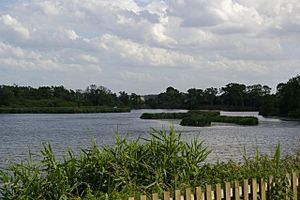Roswell Pits facts for kids
Quick facts for kids Roswell Pits |
|
|---|---|

The northern corner of the flooded pits
|
|
| Type | Nature reserve |
| Location | Ely, Cambridgeshire |
| OS grid | TL 556 806 |
| Area | 8 hectares |
| Managed by | Environment Agency |
Roswell Pits is a special nature reserve covering 8 hectares (about 20 acres). It's located just outside Ely in Cambridgeshire. This amazing place for wildlife is looked after by the Environment Agency. It's also part of a larger important area called Ely Pits and Meadows, which is recognized for its incredible nature and interesting geology (the study of rocks and earth).
Contents
A Look Back: How Roswell Pits Was Formed
For a long time, Roswell Pits was a place where people dug up a special type of clay called gault. This clay was very important because it didn't let water through. It was used to build and fix the banks of rivers in the low-lying Fens area.
Why Was Gault Clay So Important?
In the 1650s, engineers like Cornelius Vermuyden changed how rivers flowed in the Fens. This helped drain the land for farming. But as the land dried out, the peaty soil began to shrink. The ground then became lower than the rivers.
This meant it was super important to keep the river banks strong. They needed to stop water from leaking into the new farmland. Strong banks also prevented floods during heavy rain. Roswell Pits was a perfect spot for gault clay. It was right next to the River Great Ouse, so boats could easily carry the clay to where it was needed.
The Gaulters: Workers of the Pits
The people who dug and moved the gault clay were called "gaulters". They usually worked in teams of three. A team would use five boats, each about 11 meters (36 feet) long. Each boat could hold 8 tons of gault clay.
The gaulters had to provide their own horse to pull the boats. They also needed shovels and wheelbarrows for loading and unloading the clay. In 1810, a company was paid about £7.17 for 246 tons of gault. This worked out to about 3 pence per ton. By 1920, gaulters were no longer needed. New organizations took over looking after the river banks.
From Clay Pits to Sailing and Wildlife
Even after the gaulters stopped working, the pits continued to provide clay. A new pit was even started in 1947. But eventually, digging for clay stopped. Over time, the pits filled with water and became a wonderful home for wetland wildlife.
Since 1946, the pits have also been a popular spot for the Ely Sailing Club. The main area for sailing is quite large, about 40 acres (16 hectares). It's used for both relaxed cruising and exciting races. The club is even a training center. This means they can teach people how to sail.
Protecting the Pits: A Wildlife Haven
In 2006, there was some discussion about the larger lake at Roswell Pits. A local group called Ely Wildspace was worried that the new owner might want to create boat moorings. People were concerned this would harm the many animals living there.
The owner later said they wanted to create a wildlife reserve. In 2008, parts of the area were officially named a Site of Special Scientific Interest (SSSI). This recognized its special geology and wetland habitat. Later, in 2009, the SSSI area was made even bigger. It now covers almost all of the former pits, about 210 acres (85 hectares). This helps protect the area for nature.
Wildlife and Old Fossils
These old clay pits now have beautiful lakes and areas of tall reeds. They are home to many different kinds of wildlife.
Amazing Animals and Plants
You can spot many birds here, like common terns flying over the water. You might also see bright blue kingfishers darting by. Reed warblers sing their songs from the reeds.
Look closely and you might find beautiful flowers like bee orchids. And keep an eye out for amazing insects like the large emperor dragonflies buzzing around.
Discovering Ancient Life
Roswell Pits is also a special place for finding fossils! Scientists have discovered fossils of ancient creatures here. These include parts of dinosaurs, crocodiles, and turtles that lived long, long ago. It's like a window into Earth's past!
Visiting Roswell Pits
The reserve is split into two areas that are close to each other. You can get to both parts from Kiln Lane, which runs between them.
Images for kids
-
View of Ely Cathedral from Roswell Pits


